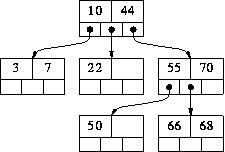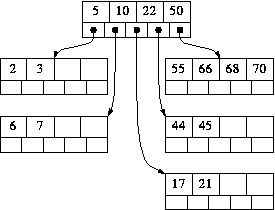- A B-tree is an M-way search tree with two special properties:
- It is perfectly balanced: every leaf node is at the same depth.
- Every node, except perhaps the root, is at least half-full, i.e. contains M/2 or more values (of course, it cannot contain more than M-1 values). The root may have any number of values (1 to M-1).

- The 3-way search tree above is clearly not a B-tree. Here is a
3-way B-tree containing the same values:

- And here is a 5-way B-tree (each node other than the root must contain
between 2 and 4 values):

- In the descriptions of our algorithms, we assume that M is odd; therefore
each node (other than the root) must contains between (M-1)/2 and M-1 values.
Insertion into A B-Tree
- To insert value X into a B-tree, there are 3 steps:
- using the SEARCH procedure for M-way trees (described above) find the leaf node to which X should be added.
- add X to this node in the appropriate place among the values already there. Being a leaf node there are no subtrees to worry about.
- if there are M-1 or fewer values in the node after adding X, then we
are finished.
If there are M nodes after adding X, we say the node has overflowed. To repair this, we split the node into three parts:
- Left:
- the first (M-1)/2 values
- Middle:
- the middle value (position 1+((M-1)/2)
- Right:
- the last (M-1)/2 values
Notice that Left and Right have just enough values to be made into individual nodes. That's what we do... they become the left and right children of Middle, which we add in the appropriate place in this node's parent.
But what if there is no room in the parent? If it overflows we do the same thing again: split it into Left-Middle-Right, make Left and Right into new nodes and add Middle (with Left and Right as its children) to the node above. We continue doing this until no overflow occurs, or until the root itself overflows. If the root overflows, we split it, as usual, and create a new root node with Middle as its only value and Left and Right as its children (as usual).
Example of Inserting Values to B-tree
For example, let's do a sequence of insertions into this B-tree (M=5, so each node other than the root must contain between 2 and 4 values):

Insert 17: Add it to the middle leaf. No overflow, so we're done.

Insert 6: Add it to the leftmost leaf. That overflows, so we split it:
- Left = [ 2 3 ]
- Middle = 5
- Right = [ 6 7 ]

Insert 21: Add it to the middle leaf. That overflows, so we split it:
- left = [ 17 21 ]
- Middle = 22
- Right = [ 44 45 ]

The node above (the root in this small example) does not overflow, so we are done.
Insert 67: Add it to the rightmost leaf. That overflows, so we split it:
- Left = [ 55 66 ]
- Middle = 67
- Right = [ 68 70 ]

- Left = [ 5 10 ] (along with their children)
- Middle = 22
- Right = [ 50 67 ] (along with their children)
Left and Right become nodes, the children of Middle. If this were not the root, Middle would be added to the node above and the process repeated. If there is no node above, as in this example, a new root is created with Middle as its only value.

- The tree-insertion algorithms we're previously seen add new nodes at the bottom of the tree, and then have to worry about whether doing so creates an imbalance. The B-tree insertion algorithm is just the opposite: it adds new nodes at the top of the tree (a new node is allocated only when the root splits).
- B-trees grow at the root, not at the leaves. Because of this, there is never any doubt that the tree is always perfectly height balanced: when a new node is added, all existing nodes become one level deeper in the tree.
Deleting A Value from A B-tree
- To insert value X into a B-tree, there are 3 steps:
- Recall our deletion algorithm for binary search trees: if the value to be deleted is in a node having two subtrees, we would replace the value with the largest value in its left subtree and then delete the node in the left subtree that had contained the largest value (we are guaranteed that this node will be easy to delete).
- We will use a similar strategy to delete a value from a B-tree. If the value to be deleted does not occur in a leaf, we replace it with the largest value in its left subtree and then proceed to delete that value from the node that originally contained it.
- For example, if we wished to delete 67 from the above tree, we would find the largest value in 67's left subtree, 66, replace 67 with 66, and then delete the occurrence of 66 in the left subtree. In a B-tree, the largest value in any value's left subtree is guaranteed to be in leaf.
- Therefore wherever the value to be deleted initially resides, the following deletion algorithm always begins at a leaf.
- To delete value X from a B-tree, starting at a leaf node, there are 2
steps:
- Remove X from the current node. Being a leaf node there are no subtrees to worry about.
- Removing X might cause the node containing it to have too few
values.
Recall that we require the root to have at least 1 value in it and all other nodes to have at least (M-1)/2 values in them. If the node has too few values, we say it has underflowed.
If underflow does not occur, then we are finished the deletion process. If it does occur, it must be fixed. The process for fixing a root is slightly different than the process for fixing the other nodes, and will be discussed afterwards.



